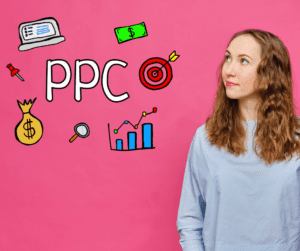The Internet has changed, and with it, so has business. Nowadays, the way we do business no longer relies on fax machines, dedicated hours, or the infamous Yellow Pages. If anything, vital to the success of a company is the following:
- Fast internet connections.
- A website.
- Social media profiles.
- A great SEO (search engine optimisation) strategy ensures that your business pops up in a search.

We have a range of exciting reads to boost your SEO that you can find here, and while we are on the topic, you should know that there is another side to achieving and improving your search engine prowess, and that is in the form of ‘SEM’ (search engine marketing).
What is search engine marketing?
SEM is the process that you use, including tools, tricks, and apps, to ensure that your business sits at or near the top of search engine rankings such as those delivered by Google using paid advertising rather than organic search.
The advertising that drives SEM can be divided into three categories:
- Pay Per Click (PPC)
- Pay Per Impression (PPI)
- Pay Per Sale/Action (PPS/PPA)
The common choice is PPC. By using PPC as part of your SEM strategy, you will pay a small fee each time someone clicks on an ad you’ve placed. Each click results in someone visiting your website or landing page. Please note that the fee that is charged per click varies. It is entirely dependent upon the cost of the keywords being used and, in simple terms, the amount that you and your business are willing to pay to drive traffic to your page or platform.

One of the main plus points of PPC as an SEM strategy is that the business must only pay if someone clicks on the advert, which means that no fee will be charged if the advert proves to be relatively ineffective or isn’t used to drive traffic to your website. This results-driven payment structure assists with your budget for an overall SEM campaign as part of a broader marketing effort and, of course, to track the return on investment (ROI) generated. You only pay for what you get.
However, PPC is only one small part of a great SEM strategy, and as you might have noticed, we used the words ‘SEM strategy’ a few times already, so what is this, and why is it important?
For this Guide to Search Engine Marketing to be genuinely effective, we must speak Strat.
SEM Strategy
Think of strategy as your roadmap towards business success. Each point is a turn on the way, and each turn, offramp, and pause eventually leads to your destination. Crucial to all business areas, it comes as no surprise that even a guide to search engine marketing requires a look at the strategy behind the outreach.
Your strategy must include the following:
- Great content
- Performance measurement
- Target groups
- Ranking
- Backlinks
Great content
As with any form of marketing, there are many more categories to worry about, but it is best to focus on these points first to begin your journey.
With great content comes excellent interaction – and with it, objectives are matched. These objectives can be brand awareness, sales increases, thought leadership, etc.; the ball is in your court. However, users are more likely to click on an advert with catchy wording than to click on a beautiful picture with no words. Likewise, you can lose the support of even loyal customers through basic typos on ads.

While adverts, catchy and gorgeous, can get people to your site, your website must follow through with great content to keep your customer there and take them through the customer journey to convert the visit into a sale. Consistent messaging is the key – and great content is the benchmark.
Performance measurement
Before uploading your ads, you can ‘Beta test’ them to see whether they meet requirements, can be optimised, and will target the right group (more on that in a bit).
Performance measurement must come before, during, and after all rollouts. As you consistently measure, you will learn what works specifically for your business and what does not. For example, you don’t want to spend time and effort creating ads and great content that doesn’t turn into leads.
Target Groups
Understanding your target market is vital to success in marketing, especially when it comes to search engine marketing. Knowing who you are going to target allows you to plan and predict buying patterns, optimal moments to offer sales, and most importantly, ensure that your advert reaches the right eyeballs.

In marketing speak, eyeballs refer to the number of views you receive on any given ad, article, or piece of content. In business, having a thousand eyeballs on an ad and only generating one sale is a red flag – ideally, the ratio is a 5 – 20% conversion. So, for that thousand, you should be getting at least 50 – 200 sales.
The key here is to target your select group of people based on their age, demographics, buying and browsing habits, and so forth. And while this seems like a lot, fear not – there is an AI (artificial intelligence) for that.
Ranking
It is no secret that when we use the web to search for our favourites, we rarely pass page 1 on Google. Unfortunately, the same laziness that is deep within us extends to our customers. That is why ranking is an essential part of SEM proficiency.
Ideally, you’re either at the top or you’re nowhere at all.
In your effort to reach that top, you must constantly upload great content, ensure your ad reach is specific to your target groups, and have thriving social media profiles.
Backlinks
Rarely discussed, and as seldom mentioned, backlinks are a prime, relatively free, and essential component to SEM.

You’ll often be told that you have a few seconds to get a potential customer to commit to a purchase. However, by using backlinks, preferably internal, you extend this time by keeping the viewer on your site even longer. A potential lead can then build further trust in you and your brand, and before you know it, you won’t just make the sale but earn the loyalty of a lifelong supporter – if your content is excellent, at least.
Final thoughts
In this guide to search engine marketing, we looked at two main aspects:
- PPC
- Strategy
Of course, there is much more to this topic – but to get you started and on the right path, begin with these two points in mind.
Use what you need for now, learn, improve, and perfect. And as you continue ensuring that your name and brand comes up first in an online search, rest assured knowing that you’re on the right path towards digital success.







